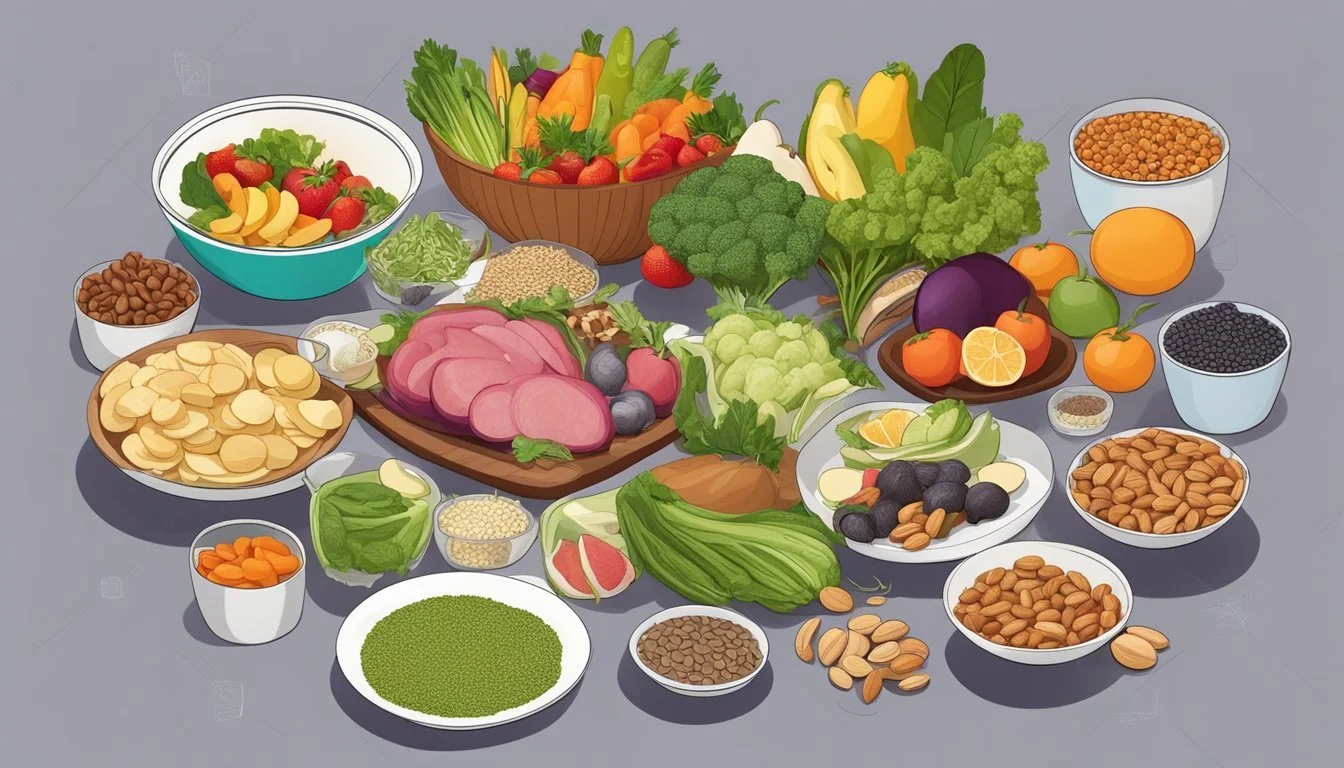8 Carnivore Diet Substitutes for Your Favorite Foods
Transition Smoothly
The carnivore diet, which focuses solely on animal-based products, presents unique challenges for those accustomed to a more varied menu. Adapting favorite recipes to fit this regimen can initially seem daunting, but with a few strategic substitutions, it's possible to maintain culinary enjoyment while staying true to carnivore principles.
Incorporating substitutes for non-carnivore ingredients allows individuals to enjoy familiar dishes without compromising their dietary goals. Whether it's recreating the texture of bread, the crunch of a salad, or the satisfaction of traditional desserts, there are effective and tasty alternatives that align with the carnivore diet guidelines. This article will explore eight practical substitutes that make transitioning to a carnivore diet more manageable and delicious.
1) Grilled Portobello Mushrooms
Grilled Portobello mushrooms provide a meaty texture that can serve as a satisfying substitute in the carnivore diet. These mushrooms, when grilled, become juicy and rich in flavor.
To prepare, start by preheating the grill to medium-high heat, around 375 to 450 degrees Fahrenheit. Remove the stems from the mushrooms and drizzle with olive oil and balsamic vinegar.
Place the mushrooms on the grill with the gill side up. Grill for 10 to 14 minutes, then flip and cook for another 2 to 3 minutes until they are juicy and browned.
Portobellos are savory and have a satisfying umami taste, making them an appealing option for those following a carnivore diet. They can mimic the texture of meat while adding variety to the diet.
2) Spaghetti Squash
Spaghetti squash is a popular vegetable among those seeking a low-carb alternative to pasta. When cooked, the flesh of this squash transforms into spaghetti-like strands, making it a versatile option for various dishes.
Though it is not part of an Animal-Based Carnivore Diet, spaghetti squash offers several nutritional benefits. A one-cup serving of cooked spaghetti squash contains approximately 42 calories, 2.2 grams of fiber, and small amounts of vitamins A and C.
For those not strictly adhering to carnivore guidelines, spaghetti squash acts as a nutrient-dense substitute for traditional pasta, aiding in weight management and adding variety to meals.
To prepare, cut the squash in half, drizzle with olive oil, and season with salt and pepper. Bake cut-side down at 400°F for 40-50 minutes or until tender. Use a fork to scrape out the spaghetti-like strands.
Spaghetti squash pairs well with numerous sauces, proteins, and vegetables, enabling creativity in meal planning. Despite being a plant-based food, its low-calorie content and fiber make it a widely accepted part of various diet plans.
Shopping for salt and pepper online is a smart way to make your purchase!
3) Zucchini Noodles
Zucchini noodles, also known as "zoodles," are an excellent low-carb alternative to traditional pasta. They are made by spiralizing zucchini into thin, noodle-like strands.
Zoodles offer a versatile addition to meals and fit well within a carnivore diet due to their low carbohydrate content.
Making zucchini noodles is simple. Using a spiralizer, the zucchini is turned into long, curly noodles. They can be made with various tools, but a spiralizer is the most common.
Cooking zoodles takes just a few minutes. A quick sauté in olive oil or cooking spray on medium-high heat, with optional additions like minced garlic, results in a light and tasty noodle alternative.
Zoodles can be paired with various animal-based sauces and toppings to align with the carnivore diet. They add texture and volume to dishes without significantly altering the carbohydrate intake.
4) Cauliflower Rice
Cauliflower rice is a popular alternative to traditional grain-based rice. It fits well within low-carb and keto diets, making it a versatile choice for those looking to reduce carbohydrate intake.
The preparation of cauliflower rice involves washing and cutting cauliflower into small florets. These florets are then processed into rice-sized pieces using a food processor.
This substitute can be cooked in various ways. One common method includes microwaving the cauliflower rice in a steam bag for a few minutes. Alternatively, it can be sautéed in a pan with some oil and seasonings.
Though not suitable for a strict carnivore diet, cauliflower rice is praised for its texture and ability to mimic traditional rice. It adapts well to a variety of dishes, serving as a base or side dish.
For those on diets that allow some plant-based foods, cauliflower rice provides a low-calorie, nutrient-rich option. It can be flavored and seasoned in many ways to suit different culinary preferences.
Overall, cauliflower rice offers a convenient and healthy alternative to grain-based rice, especially for those aiming to reduce carbs while maintaining diverse meal options.
5) Lettuce Wraps
Lettuce wraps are a versatile and refreshing alternative for those on a carnivore diet. Though traditionally used in sandwiches and other wraps containing various ingredients, lettuce can serve as a handy vehicle for meat and cheese fillings, adhering to carnivore guidelines.
Romaine or iceberg lettuce works best due to their sturdy leaves. These types can hold fillings without tearing easily. It's crucial to ensure the lettuce is dry before assembling the wrap to maintain its structural integrity.
The wrap can include cooked or cold cuts of meats like chicken, turkey, or beef. Adding bacon or cheese enhances flavor and texture. Simple condiments like mustard or mayonnaise can be used sparingly, provided they fit within the carnivore diet's animal product criteria.
Preparation is straightforward. Lay several large leaves of lettuce on parchment paper, layer chosen meats and cheeses, and roll tightly. Cutting the wrap in half makes it easier to handle and eat. The result is a crisp, satisfying meal option that stays within carnivore-friendly food choices.
6) Almond Flour Pancakes
Almond flour pancakes offer a satisfying alternative to traditional pancakes while on the carnivore diet. Made with almond flour, these pancakes are low-carb and gluten-free, catering to various dietary preferences without compromising on taste.
To make almond flour pancakes, whisk together almond flour, eggs, and a suitable milk substitute until smooth. Preheat a non-stick pan over medium heat and add a small amount of oil.
Pour the batter into the pan, forming small circles. Cook until bubbles appear on the edges, then flip and cook the other side until golden brown.
Almond flour provides a rich, nutty flavor and packs a healthy dose of fats and proteins, making it suitable for those keeping carbohydrate intake to a minimum. For variety, some recipes may include protein powder and psyllium husk for added texture and nutritional benefits.
These pancakes can be topped with sugar-free syrup, berries, or enjoyed plain. They provide a delicious, filling breakfast that aligns with the carnivore diet principles.
7) Coconut Flour Tortillas
Coconut flour tortillas offer a low-carb and gluten-free alternative to traditional tortillas. They are made from coconut flour, which is high in fiber and healthy fats. These tortillas cater to those following grain-free diets but are not typically included in strict carnivore diets.
They provide a pliable, soft texture, making them suitable for various wraps and Mexican dishes. While regular coconut flour tortillas mix with ingredients like tapioca flour and flaxseed, this goes against the carnivore diet’s principles.
Instead, in a carnivore-friendly approach, consider using pork rinds or other animal-based ingredients for tortilla alternatives. Pork rinds, when ground into a fine powder, can act as a binding agent without the inclusion of plant-based flours. This creates a low-carb, animal-based wrap suitable for the diet.
8) Baked Eggplant Slices
Baked eggplant slices can be a versatile and delicious substitute for meat on a carnivore diet when you're looking for a meat-free alternative. These slices can be prepared by preheating the oven to 400 degrees F and lining a rimmed baking sheet with parchment paper.
First, wash the eggplants under cold water to remove any dirt. Then, dry each one thoroughly with a clean kitchen towel or paper towels.
Slice the eggplants into even rounds to ensure they cook uniformly. Arrange the slices in a single layer on the prepared baking sheet.
Bake the eggplant slices for around 25-30 minutes or until they are golden brown and tender. They can be enjoyed as a standalone dish or used as a base for various recipes.
Benefits of the Carnivore Diet
The Carnivore Diet is renowned for focusing solely on animal products, potentially offering numerous nutritional and health benefits. Key advantages include nutrient-dense food consumption and significant health improvements reported by many followers.
Nutritional Advantages
The Carnivore Diet prioritizes nutrient-dense foods rich in essential vitamins and minerals. Animal products, especially organ meats like liver and kidney, are excellent sources of Vitamin B12, iron, and zinc.
Meat-based diets are also high in protein and healthy fats, providing sustained energy. These nutrients are vital for muscle growth, maintenance, and overall bodily function.
Furthermore, consuming meat eliminates antinutrients like lectins and phytates found in many plant foods, which can interfere with nutrient absorption.
Health Improvements
Many adopting the Carnivore Diet report significant health benefits, including better blood sugar regulation and weight loss. This diet's high protein content can enhance satiety, reducing overall calorie intake.
There is also evidence suggesting improvements in mental clarity and mood. Some attribute this to the diet's elimination of potentially inflammatory plant compounds and its emphasis on omega-3 fatty acids from fish and grass-fed meats.
Reduced inflammation and improved gut health are other reported benefits. The absence of fiber and other fermentable carbohydrates may alleviate symptoms of digestive disorders like IBS. The diet's simplicity and focus on whole, natural foods contribute to these positive outcomes.
Adapting to the Carnivore Diet
Switching to a carnivore diet involves understanding how to substitute typical foods with carnivore-friendly options and planning meals to ensure a smooth transition.
Understanding Food Substitutes
Adapting to the carnivore diet means replacing common staples with animal-based alternatives. Instead of breads and grains, focus on meats, eggs, and dairy.
For snacks, options like cheese slices or pork rinds can replace chips or crackers. Instead of mashed potatoes, try mashed cauliflower with butter and cream. Consider using organ meats like liver for nutrient diversity.
Using bone broths can help maintain hydration and electrolyte balance. Incorporating nutrient-dense animal organs and high-fat cuts of meat is essential for meeting dietary requirements.
Meal Planning Strategies
Planning meals helps mitigate adaptation challenges. Start with simple meals, such as steak for dinner or bacon and eggs for breakfast.
Gradually integrate more complex dishes, such as casseroles made with ground meat and cheese. Transitioning can begin by making one of three daily meals entirely carnivore, like a steak salad (without the greens) for lunch.
Aim for variety in meat types, including fish and poultry, to balance nutrient intake. Prep meals in advance to avoid last-minute temptations to stray from the diet. Planning ensures consistency and aids in smoother adaptation.







